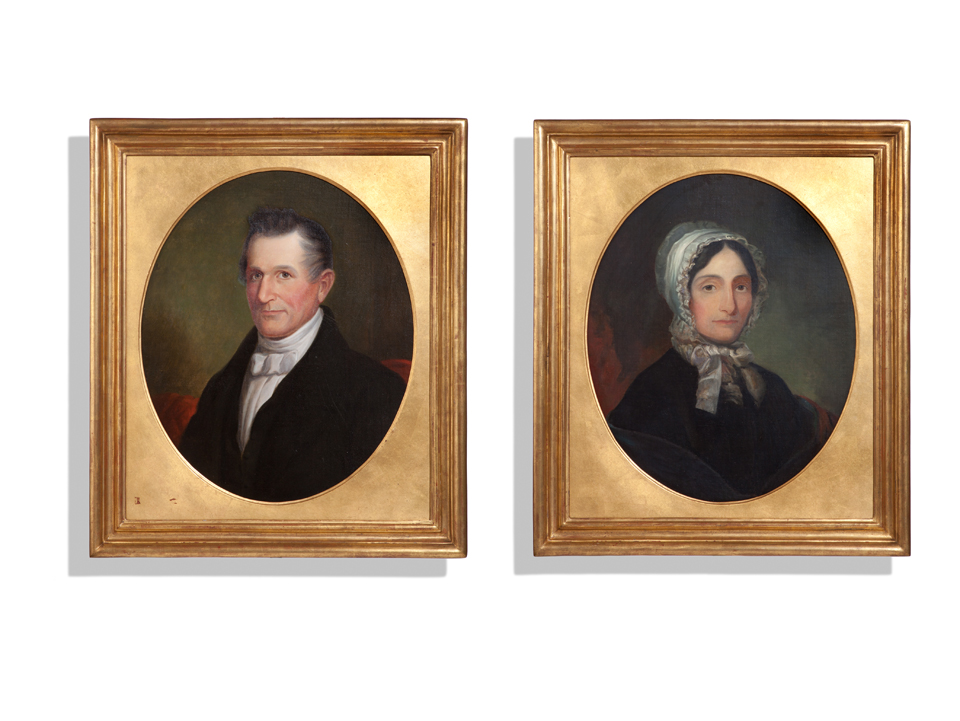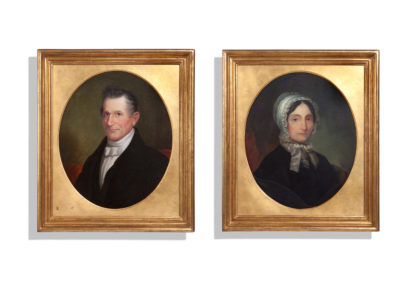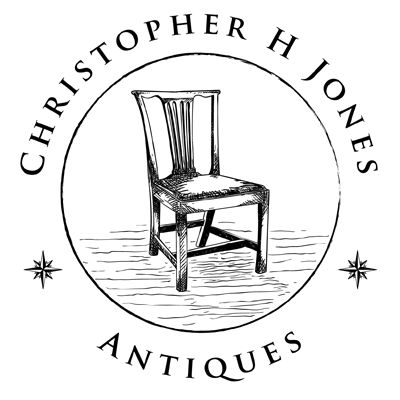Subjects ~ Peter Blow (1771 -1832) and Elizabeth Taylor Blow(1785- 1831)
Oil on Canvas ~ 20” x 24” (overall 27” x 31”)
Unknown Artist
Circa 1820 – 1830
Commentary: Peter and Elizabeth Blow were both Virginians who, like many on their peers, moved westward seeking greater opportunities for themselves and their families. The Blows were the owners of the slave Dred Scott, born in Southampton County, circa 1795, whom they took from Virginia to Alabama and eventually to Saint Louis, Missouri. There Scott’s attempt to gain his freedom through a series of court cases that eventually reached the United States Supreme Court would generate a national controversy and, in the view of many historians, become a major factor in the country’s descent into civil war. Scott’s history of ownership in the Blow family, his subsequent sale around the time of the deaths of Peter and Elizabeth, and the support of Scott’s suit by the Blow’s sons, with whom he had grown up, would all figured prominently in Scott’s legal battles.
Peter Blow was born in Southampton County, Virginia in 1771, the son of Richard (1746-1833) and Ann Blow who had extensive land holdings and family connections in the region. The Blow family was associated with Tower Hill on the Nottoway River straddling Sussex and Southampton Counties and the Olde Place further inland in Southampton County. Richard began his career as a planter but rapidly developed a commercial network that spanned the region including South Quay, Jerusalem (Courtland), Petersburg and Norfolk Peter was born in Southampton County and married Elizabeth Taylor, of the same county, the only daughter of Henry and Rebecca Tyson Taylor, in 1800. Peter served as an officer in the Sixty Fifth Virginia Militia during the War of 1812 and henceforth seems to have assumed the title of Captain Blow. In 1818 Peter and Elizabeth moved to a cotton plantation in Madison County, near Huntsville Alabama although it is not clear what if any local connections there may have prompted the Blows to settle in the particular locale. Within a few years they moved to Florence Alabama, where they remained for some ten years (possibly running small hotel) until 1830 when they relocated to Saint Louis. The portraits may have been done prior to Peter and Elizabeth’s departure from Virginia or at a later date.
In Saint Louis they rented a large house on Pine Street, near Main, where they established the Jefferson Hotel. Elizabeth died in 1831 after what was apparently a long illness. Peter Blow died the following year leaving his estate to his two unmarried daughters and two youngest sons. Some confusion surrounds the exact terms of the sale or transfer of Dred Scott from Peter Blow to the Army surgeon Dr. John Emerson and whether the transaction occurred before Blow’s death or was a part of the settlement of his estate. Scott’s ownership by Blow and subsequently by Emerson are however facts that were never at issue in the series of court cases to follow.
Scott would eventually accompany Emerson on his postings to Rock Island, Illinois and to Fort Snelling located in a part of the Wisconsin Territory that is within modern day Minnesota. At Fort Snelling he met and married a female slave named Harriet who was purchased by Dr. Emerson to facilitate the union. The couple returned to Saint Louis with Emerson when he was reassigned to Jefferson Barracks in that city and remained there after Emerson’s death in 1843. The suit seeking to gain freedom for himself and his wife filed by Scott in Circuit Court in Saint Louis in 1846 essentially claimed that, having resided for a time in a free state, that the Scott could not be re-enslaved against their will upon their return to Missouri. During the years the case proceeded through the Missouri and Federal Courts it became the focus of intense partisan debate surrounding the legal basis for slavery and the motives of the various participants in the case. The case was followed nationally and bitterly contested by supporters of slavery and of abolition. The decision of the Supreme Court denying his claim to freedom fueled an enormous increase in partisan controversy and became a rallying point for those who feared that slavery could not be defeated through the courts.
While they have differed on the factors which motivated two of the Blow’s sons, Henry and Taylor, to support Scott’s cause, historians have been fascinated by the roles of the descendents of the slave’s owners in the case. (See accompanying commentary on portraits of Taylor Blow and his wife, Eliza) By some accounts, Scott was encouraged by these two men, with whom he had grown up, to file his original suit, although this is unclear. It is incontestable however that both men gave depositions in the case and both seem to have provided financial and moral support to Scott’s cause. After Scott’s case was lost, Taylor Blow purchased the slave who had formerly been owned by his father and gave both Dred Scott and his wife their freedom.
Provenance: By direct descent in the family.
Peter Blow & Elizabeth Taylor Blow
To their son, Taylor Blow (1820-1869) m. 1844 Eliza Augusta Wahrendorff
To their daughter, Augusta Wahrendorff Blow m. Louis Rice Lemoine (1858-1926)
To their niece, Katherine Lemoine Perkins (1901 -1992) m. Lloyd Crow Stark (1886-1972)
To their daughter, the current owner.
Condition: The portrait of Peter Blow survives in excellent condition. It was lined at the time of an earlier restoration and reframed. A limited area of the surface around the face was recently cleaned of severely yellowed varnish and revarnished by conservator Alexandra Tice of Chevy Chase, Maryland. The painting retains its original stretcher constructed of white pine. The portrait of Elizabeth Blow has been mounted on board and reframed in early 20th century by Hannah Mee Horner of Philadelphia whose tag remains on the verso. It was recently lightly cleaned by conservator Alexandra Tice who removed small areas of earlier, awkwardly applied inpainting.
Price: SOLD



